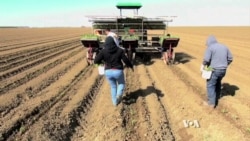California Governor Jerry Brown residents of the state must reduce their water consumption by 25 percent to cope with a major drought, and local communities are drawing up new restrictions. Residents, businesses and water agencies are already making changes.
This is the fourth year in a row of below average rainfall, which has created moderate to extreme drought conditions. Bill McDonald of the Metropolitan Water District of Southern California says new restrictions should save a precious resource that is drying up.
“Right now, we rely on a lot of snow and rain, and that is not happening," said McDonald.
Some of the state's water comes from northern California and moves through aqueducts to the farm rich Central Valley and water-hungry cities in the south.
Farms uses 80 percent of the state's water to produce much of the nation's fruit, vegetables and nuts. Farming is largely exempt from the new restrictions, but many farms have seen their water allocations cut to zero.
They use groundwater for crops, and new rules for pumping it may help preserve the water table, which is being depleted quickly in some places.
Analyst Caitrin Chappelle of the Public Policy Institute of California says the public wants stronger conservation measures.
“Our recent survey asked the question, do you think local and state government is doing enough about the drought. And we saw the majority said no," said Chappelle.
Among new rules already in place, restaurants will face fines if they offer water to customers who have not asked for it. At a Mexican restaurant in Los Angeles, owner Gilberto Cetina says the rule will save more than just drinking water.
“It is the water, it is the ice, the electricity you use to make the ice, the cut when you give the water, or if you use glasses, the water you use to wash the glass," said Cetina.
Californians say they want to help.
“We can just do what we can, turn off the water in between brushing our teeth," said one.
Major water users, such as golf courses, will face new restrictions, and local communities are drawing up rules to meet the target of a 25 percent reduction by next year.
Some homeowners are being paid to tear out grass and to landscape with drought-tolerant native plants.
Bill McDonald says more homeowners are installing efficient drip irrigation systems.
“And that is the future. That is where we are going, because putting drinking water on a landscape that is ornamental is not a good use of resources," he said.
Other new restrictions will be coming for businesses and public agencies, as well as to residents. Restaurateur Gilberto Cetina says he is doing his part, and has already tried charging his customers for water.
“I got 10 customers mad and I stopped it. But I think we can do it now. I think now is the right time to do it," he said.
Analysts say there is no single solution to California's water shortage, but education, better planning and conservation will help the state get through its periodic droughts.
They say long-term solutions include recycling waste water and strengthening the distribution system, using pricing to encourage more efficient water use and using technology to reduce waste.








